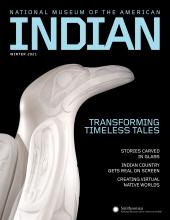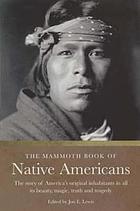My answer? There are many definitions of who is an Indian. As a starting point, “Indian” is a misguided label that spread through Europe after 1492. Native people have always associated themselves with their tribe(s) and referenced their tribal names in their tribal languages. Explorers and colonists from Spain, France, England, the Netherlands, and Russia, among other countries, began naming tribes they encountered in North America in European languages. As English became the primary language in the United States, American Indian (to distinguish us from Indians native to India) became the collective term used.
American Indians generally belong to or are descendants of tribes indigenous to what is now the United States.
In modern times the federal government, states, tribes and individuals have formed their own definitions of who is Indian. Three important criteria to consider when answering this question are federal legal definitions, ethnological Indian ancestry, and tribal membership. The federal government lists 565 federally recognized American Indian tribes and Alaskan Native Communities. Twenty-two states also have criteria for recognizing tribes within their boundaries. The majority of state-recognized tribes, however, are not federally recognized. For United States Census purposes, an individual simply needs to self identify themselves as American Indian and Alaskan Native to be counted in the final summary.
The question of who is an Indian is often debated among Indian people. […]
Skin color does not make you Indian. In our museum I have heard non-Indians comment they have seen an Indian simply if the person they saw has the long black hair, brown skin, and high cheek bones associated with the classic Indian image. In reality, there are proud Indians with blonde hair and blue eyes or black skin. Through intermarriage, their Indian descent comes from one or both Indian parents.
Each tribe has the sovereign authority to define who its members are and who is eligible to be enrolled. […]
Ultimately the question, “Who is an Indian?” is determined by tribal law.
Source: “Who is Indian, and what makes a person an Indian?” by Dennis Zotigh January 26, 2011
Address: http://blog.nmai.si.edu/main/2011/01/who-is-indian-and-what-makes-a-person-an-indian.html
Date Visited: 30 March 2021
“Native American storytellers use the oral tradition to teach life lessons, tribal histories, and the nuance of languages. Such stories are an essential tool in passing knowledge from one generation to the next.” | Video channel of the National Museum of the American Indian >>
Indigenous people across North America depend on Native media outlets for essential information about their communities and tribal affairs. These newspapers, newsletters, magazines, radio and television broadcasts as well as online publications are often produced in places that otherwise lack a reliable source of timely, accurate and contextual coverage of what impacts their daily lives. Indigenous media, however, does more than distribute news. It serves as a community forum that can help reinforce cultural values and languages. Ultimately, it holds the potential to reaffirm an Indigenous community’s identity.
Source: Bryan Pollard (Cherokee Nation) in “More than News: Indigenous media empowers native voices and communities” (American Indian Magazine, Smithsonian, Summer 2020)
URL: www.AmericanIndianMagazine.org
Date visited: 27 November 2020
About the Museum
A diverse and multifaceted cultural and educational enterprise, the National Museum of the American Indian (NMAI) is an active and visible component of the Smithsonian Institution, the world’s largest museum complex. The NMAI cares for one of the world’s most expansive collections of Native artifacts, including objects, photographs, archives, and media covering the entire Western Hemisphere, from the Arctic Circle to Tierra del Fuego.
The National Museum of the American Indian operates three facilities. The museum on the National Mall in Washington, D.C., offers exhibition galleries and spaces for performances, lectures and symposia, research, and education. The George Gustav Heye Center (GGHC) in New York City houses exhibitions, research, educational activities, and performing arts programs. The Cultural Resources Center (CRC) in Suitland, Maryland, houses the museum’s collections as well as the conservation, repatriation, and digital imaging programs, and research facilities. The NMAI’s off-site outreach efforts, often referred to as the “fourth museum,” include websites, traveling exhibitions, and community programs.
Since the passage of its enabling legislation in 1989 (amended in 1996), the NMAI has been steadfastly committed to bringing Native voices to what the museum writes and presents, whether on-site at one of the three NMAI venues, through the museum’s publications, or via the Internet. The NMAI is also dedicated to acting as a resource for the hemisphere’s Native communities and to serving the greater public as an honest and thoughtful conduit to Native cultures—present and past—in all their richness, depth, and diversity.
Source: About the Museum | National Museum of the American Indian
Address: http://www.nmai.si.edu/about/
Date Visited: Sun Aug 27 2017 17:18:26 GMT+0200 (CEST)
We are the experts that connect to our people, and we know how to talk to our people in our communities. We know how to fairly represent them […] giving voice to people who have never had much of a voice in the last few hundred years. [T]he key for Native media to succeed is for it to connect to its cultural roots.
Source: Canadian tv-producer Francine Compton in “More than News: Indigenous media empowers native voices and communities” (American Indian Magazine, Smithsonian, Summer 2020)
An insider’s view on the causes and effects of America’s “Indian problem”:
The white man does not understand the Indian for the reason that he does not understand America. He is too far removed from its formative processes. […]
The attempted transformation of the Indian by the white man and the chaos that has resulted are but the fruits of the white man’s disobedience of a fundamental and spiritual law. The pressure that has been brought to bear upon the native people, since the cessation of armed conflict, in the attempt to force conformity of custom and habit has caused a reaction more destructive than war, and the injury has not only affected the Indian, but has extended to the white population as well. Tyranny, stupidity, and lack of vision have brought about the situation now alluded to as the ‘Indian problem’. There is, I insist, no Indian problem as created by the Indian himself.
Source: “What the Indian Means to America”, excerpted from Land of the Spotted Eagle by Luther Standing Bear (who “became hereditary chief of the Oglala Sioux in 1905”) in The Mammoth Book of Native Americans: the Story of America’s original inhabitants in all its beauty, magic, truth and tragedy by Jon E. Lewis (ed.), London: Constable & Robinson Ltd.: 2004 (pp. 348-9)
URL: http://www.worldcat.org/oclc/784882158
[Bold typeface added above for emphasis]
See also
CBC Unreserved (Canada) radio space for indigenous community, culture, and conversation
eLearning: Center for World Indigenous Studies
Indigenous people are at the forefront of the struggle to save the planet
Internet Archive | Archive.org
People’s Archive of Rural India (PARI) | RuralIndiaOnline.org
Recovering tribal culture from the misrepresentation of mainstream media
Storytelling | Success stories

